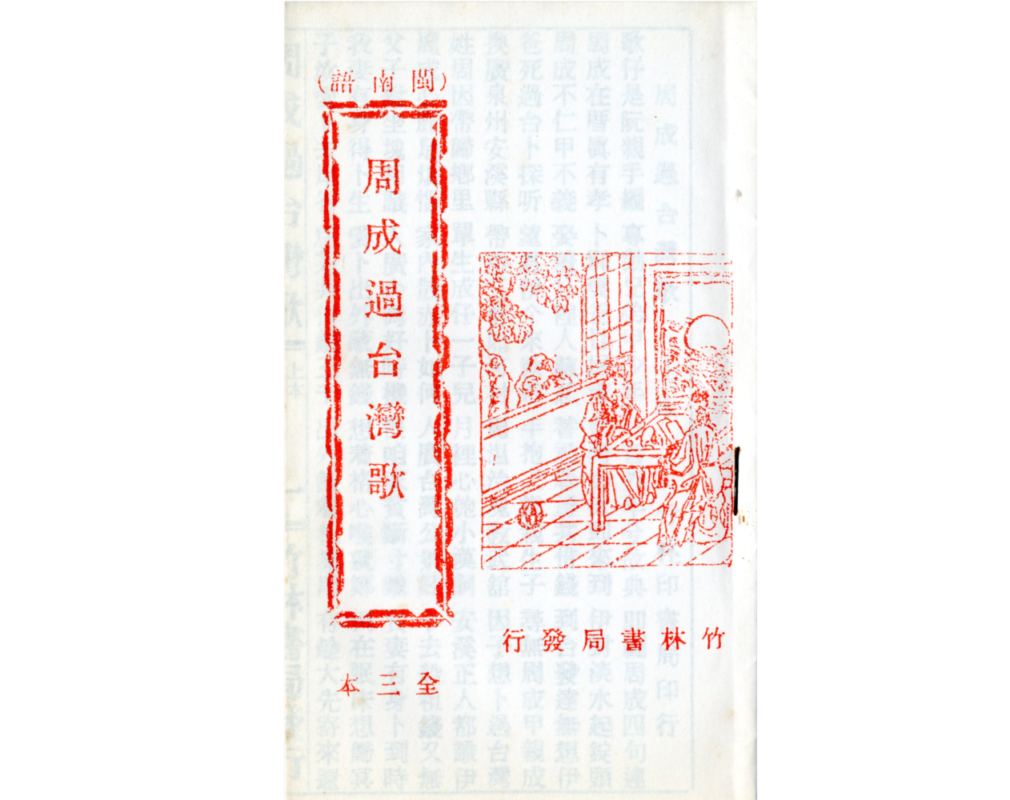自古人類對於浩瀚宇宙的奧秘、自然環境的變化、人的前世來生等種種無法解開的謎題,常歸咎於不可思議的奇幻世界,在嘗試解釋這些不可知事物的過程中,鬼怪被想像出來,成為禁忌的一部分,相關傳說、神話亦因應而生,因此鬼怪的生成與人們恐懼、害怕及不可知的事物息息相關。
「臺灣」這座四面環海的島嶼,由於地理位置與自然環境的特殊性,歷經大航海時代、明鄭、清領、日治至今,在多元族群並存之下,產生豐富多樣的鬼怪文化,並在民間文學的口傳或者歷代文人的書寫,鬼怪成為創作靈感泉源,賦予文學中更多的想像空間。然後在現代化的過程中,諸多妖異故事散佚在時間洪流中,鬼怪傳說亦逐漸被遺忘。臺灣知名民間文學學者胡萬川曾感嘆:「如今在學的大中小學生,對臺灣的民間故事如〈虎姑婆〉一類,已較少或不再聽聞,則是不可否認的事實。實際上會把〈虎姑婆〉故事講得完整的學生已不多,聽過〈蛇郎君〉故事的更少,會講〈蛇郎君〉的人更是稀見。」其實現今逐漸失去這些傳說故事,也失去孕育在地文化的豐厚土壤。
現今社會大眾以為妖怪是受到外來文化的影響而來,其實臺灣本身有很豐厚的鬼怪文化。原本流傳在臺灣鄉野之間妖鬼奇譚,透過歷代文人記錄在古文書之中,不同身分的記錄者,都會以不同的立場與視角來檢視這些傳說。例如明清時期遊宦文人旅居臺灣,認為島上蟄伏異獸、海中藏匿怪物,第一位以「魔幻寫實」的筆法描繪臺灣的詩人――孫元衡將臺灣視為一座「魔島」。日治時期,臺灣與日本民俗學者以文化人類學的精神整理臺灣各地、各族群的鬼怪傳說故事,讓原住民的妖精鬼怪文化,能初步以文字記載下來。在民間文學方面,則以「說唱藝術」的傳唱方式,成為鬼怪傳說流傳民眾之間的重要媒介,鬼怪文學在臺灣文學史發展中是無法忽視的存在。
一、明清時期的黯影潛伏
 江日昇《臺灣外記》曾描述澎湖火鱷,相傳身上金黃鱗甲能散發火焰,棲游於黑水溝深海。圖/國立臺灣文學館提供
江日昇《臺灣外記》曾描述澎湖火鱷,相傳身上金黃鱗甲能散發火焰,棲游於黑水溝深海。圖/國立臺灣文學館提供
明清時期的遊宦文人,主要以古典詩詞、遊記等寫作形式留下鬼怪奇譚紀錄,尤其在各方志中〈災祥篇〉記下天災異象與妖異奇俗,如清代江日昇《臺灣外記》曾描述澎湖火鱷;清代林豪《東瀛紀事》〈災祥〉篇中,有隻「人面牛」的妖怪曾預言戴潮春事件。這些災異紀錄,依循儒家「天人感應」的政教思想,提供當地官員作為「政事變化」的徵兆,這些妖異說法多屬穿鑿附會之嫌,這種將異地「浪漫化」的書寫視角,呈現出「中心–邊陲」的文化詮釋脈絡。
二、日治時期的耕耘踏查
19世紀末,日本政府為治理臺灣成立「臨時臺灣舊慣調查會」,進行大規模的文化考察與紀錄,將新時代的民俗學、文化人類學等研究帶入臺灣,讓這些漢人民俗信仰、怪談敘事,以往被認為荒誕不經的傳說故事,開始以「科學」重新檢視,如片岡巖、鈴木清一郎、增田福太郎等,並將原住民鬼怪傳說初步以文字記載下來,如伊能嘉矩、佐山融吉等人,這些為日後鬼怪文學書寫題材上提供許多重要的資料。此期民間學者也有投入許多人力整理書寫,如池田敏雄、金關丈夫等人主編的《民俗臺灣》,李獻璋《臺灣民間文學集》(1936)等,日人作家也對於臺灣這個充滿異國情調的殖民地,開始嘗試將鬼怪元素放進小說創作之中,如西川滿、佐藤春夫等,尤其是佐藤春夫的〈女誡扇綺譚〉(1925)可說是臺灣恐佈文學的濫觴。
日治時期,報紙成為大眾傳播媒介,從《臺灣日日新報》刊載許多奇聞軼事,滿足臺灣民眾對於鬼怪傳說的好奇心,如魔神仔傳說最早出現於1901年〈遇魔述異〉之中,水鬼傳說則是當時流傳最為廣泛的鬼怪報導。另外在《三六九小報》(1930-1935)上以野狐禪室主為筆名的洪鐵濤,以「續聊齋」專欄,述說流傳臺南的在地故事。
 佐山融吉、大西吉壽《生蕃傳說集》。圖/國立臺灣文學館提供
佐山融吉、大西吉壽《生蕃傳說集》。圖/國立臺灣文學館提供
三、1950到1970年代的沉潛蟄伏
1945年終戰之後,國民政府接收臺灣,1950年代實行戒嚴,凡屬怪力亂神之刊物,皆禁止出版,使得日治時期已初具規模的鬼怪研究被迫中斷。但此時仍有許多學者默默地耕耘、延續日治時期以來的民俗調查,早期如廖漢臣、王詩琅、黃得時、楊雲萍等人。
在民間則以更普遍、與大眾更加親近的傳播媒介――「唸歌」,將鬼怪奇譚以傳唱方式保存下來,民間藝人以彈奏月琴或大廣弦,搭配傳統曲調的七字調或江湖調,以臺語吟唱,其內容深具道德倫理的教化意義。與鬼怪相關的唸歌,如臺灣最著名女鬼傳說――林投姐、月裡,亦具有勸世為善之意涵。
 《周成過臺灣歌》。圖/國立臺灣文學館提供
《周成過臺灣歌》。圖/國立臺灣文學館提供
四、1980到1990年代的再復興
1980年代之後受到外來文化的引進與影響,司馬中原承襲中國聊齋傳統,引起當時說鬼故事的流行,例如「軍中鬼故事」在1990年代蔚為風潮,成為六、七年級的兒時回憶。1960年代時,歐美哥德小說開始譯介入臺灣,1980至1990年代大量翻譯的哥德羅曼史,加上以希區考克為首的驚悚電影,使得西方恐怖風格深入人心。日本漫畫則在1970年代大舉佔據臺灣的閱讀市場,其中恐怖漫畫即為一大重要分支,1990年代引入臺灣的日本怪談小說與電影,曾造成當時的熱潮,並進一步影響臺灣的相關創作。
隨著1980年代末期臺灣政治社會的改革開放,在文化上也興起了本土化運動,研究者重新尋找臺灣歷史、民俗上的鬼怪文化,除重新進行古文獻紀錄的整理與辨認,並進入田野現場,採集早已佚失鄉野的鬼怪傳說,如胡萬川進行高雄縣、彰化縣、雲林縣、臺中縣、臺南縣、苗栗縣、桃園縣等地毯式的調查。原住民傳說則在隨著族群主體性增強後,由原住民作家、學者主動記錄下屬於自己的神話傳說故事,如孫大川總策畫《臺灣原住民的神話與傳說》共計十族 ; 霍斯陸曼.伐伐《玉山的生命精靈:布農族口傳神話故事》則有布農族太陽神話〈眼睛被射傷的太陽〉、洪水神話〈奮勇的蟾蜍與紅嘴鵯鳥〉。
五、2000年之後的百花齊放
近年來,鬼怪研究更成為臺灣的一門顯學,研究者致力搜尋以往躲藏在暗處的鬼怪歷史,透過系譜化的知識工程建構出屬於臺灣的鬼怪文化,如林美容、李家愷《魔神仔的人類學想像》探討臺灣魔神仔的信仰,臺北地方異聞工作室《唯妖論》(2016)考察在地文化的妖鬼傳聞,何敬堯《妖怪臺灣:三百年島嶼奇幻誌.妖鬼神遊卷》(2017)則爬梳古文獻中曾出現過的妖鬼蹤跡。
。圖/國立臺灣文學館提供.jpg) 何敬堯,《妖怪臺灣:三百年島嶼奇幻誌.妖鬼神遊卷》(2017)。圖/國立臺灣文學館提供
何敬堯,《妖怪臺灣:三百年島嶼奇幻誌.妖鬼神遊卷》(2017)。圖/國立臺灣文學館提供
作家也開始以此為養份,進行本土鬼怪的嶄新創作,如王家祥《魔神仔》(2002)以歷史小說的架構,對於臺灣史前矮黑人歷史的進行想像。甘耀明《殺鬼》(2009)與連明偉《青蚨子》(2016)皆以自身成長環境出發,以在地奇譚來鋪寫鄉野記憶,如苗栗獅潭客家庄與宜蘭頭城當地鬼怪傳說。原住民作家也將魔怪、巫術等元素,融入於小說之中,呈現出臺灣原住民文學的獨特氛圍,如巴代《巫旅》(2014)描繪卑南族大巴六九部落傳統巫覡文化;乜寇.索克魯曼《東谷沙飛傳奇》(2008)以布農族神話中的大洪水傳說為創作基底。在大眾文學中,也將臺灣獨特的妖鬼奇譚寫入作品之中,如紀羽綾《林投記》(2015),取材自臺南的民間故事「林投姐」,故事表面講述厲鬼索命,背後卻是呈現土地徵收議題。這蓬勃發展的現象皆在在反映出年輕世代對臺灣主體意識的崛起,企圖從俗民生活中掏洗出真正臺灣文化的構成,因為鬼怪是從社會風俗中誕生,為最純粹的文化產物。
六、當代的新方向,跨界合作
流傳數百年的鬼怪故事,是臺灣悠長歷史中引人遐想的奇妙軼聞,更象徵在地文化的黑暗結晶。當這些不可思議的故事繼續流傳於當代,也成為文學創作時,極為重要的奇幻元素,豐富臺灣文學的幻想成份。
新世代的妖怪文學應從文史研究、小說創作出發,並與動漫、插畫合作,透過圖像讓臺灣鬼怪真的從文字中、書本上現身,成為活生生的故事角色。並進一步與多媒體藝術與遊戲進行跨界合作,如桌遊、電影、影像、遊戲等,藉由說自己土地的故事展現臺灣妖鬼文化的多元性,如臺北地方異聞工作室的《說妖》,不只有小說作品,更創作出桌上遊戲,未來並進一步發展成手機遊戲。將鬼怪傳說改編影視,更是未來臺灣文學透過題材的轉譯,來發展影視產業是極具競爭力的方向,如2015年、2017年上映的《紅衣小女孩》或《通靈少女》影集,即是十分成功的案例。
。圖/AKRU提供.jpg) 《文學少女黃鳳姿》(2014)。圖/AKRU提供
《文學少女黃鳳姿》(2014)。圖/AKRU提供
曾有云 : 沒有鬼怪傳說的國度是沒有文化的,代表著鬼怪傳說是俗民文化很重要的環節與展現,因為這些傳說故事能夠形塑一個族群對於世界的觀點,也與當地歷史緊密連結。未來希望在現今鬼怪學蓬勃發展之際,期待「鬼怪」這極具臺灣獨特性IP(Intellectual Property),能與當代藝術各領域的跨界合作,開創出臺灣文學再生產、臺灣文化再發展的新契機。